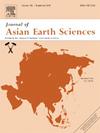东南亚晚二叠世—早三叠世成矿系统岩浆—热液演化:来自泰国Chatree浅成热液金矿床的启示
IF 2.4
3区 地球科学
Q2 GEOSCIENCES, MULTIDISCIPLINARY
引用次数: 0
摘要
Loei矿带是东南亚大陆岩浆弧相关地体中Cu-Au- fe省的重要成矿带,主要赋存浅成热液型和斑岩型Au- Au矿床。然而,岩浆活动与低硫化度浅成热液矿化的关系尚不清楚。地质年代学和稳定同位素研究表明,热液流体在成矿过程中起主导作用。本文主要从岩石学、地球化学、年代学、锶同位素等方面探讨岩浆与金矿化的联系。矿床赋存于石炭系至三叠系火山和沉积层序中,主要为安山岩和流纹岩角砾岩;安山岩火山岩主导下层序,生成262 ~ 250 Ma的U-Pb锆石年龄,安山岩和玄武岩岩脉生成244 ~ 238 Ma的U-Pb锆石年龄。40Ar/39Ar定年限制成矿时间为262 ~ 244 Ma,与晚二叠世至早三叠世一致。地质年代学分析表明,至少发生过两期岩浆活动:晚二叠世(262-250 Ma)和早三叠世(250-238 Ma)。Sr同位素比值最高(0.708765 ~ 0.717607)的强金脉表明,热液流体与下伏沉积基底的相互作用影响了矿石流体。本文章由计算机程序翻译,如有差异,请以英文原文为准。

Magmatic-hydrothermal evolution of the Late Permian-Early Triassic Southeast Asian metallogenic system: Insights from the Chatree epithermal gold deposit, Thailand
The Loei mineral belt is the significant for the Cu-Au-Fe province in magmatic arc-related terranes in mainland Southeast Asia, hosting epithermal Au and porphyry Cu-Au deposits. However, the relationship between magmatic activity and low-sulfidation epithermal mineralization remains unclear. Geochronological and stable isotope studies suggest that hydrothermal fluids played a dominant role in ore formation. This study focuses on petrography, geochemistry, geochronology and strontium isotopes to investigate the linkages between magmatic and gold mineralization. The deposit is hosted by Carboniferous to Triassic volcanic and sedimentary sequences, mainly in andesitic and rhyolitic breccias; andesitic volcanic rocks dominate the lower succession, yielding U-Pb zircon ages of 262–250 Ma while andesitic and basaltic dikes yield 244–238 Ma. Adularia 40Ar/39Ar dating constrains mineralization to 262–244 Ma, coinciding with the Late Permian to Early Triassic age. The geochronological analysis suggests at least two episodes of magmatism occurred: Late Permian (262–250 Ma), and Early Triassic (250–238 Ma). Insight into intense gold veins with the highest Sr isotope ratios (0.708765–0.717607) indicates that hydrothermal fluid interactions with the underlying sedimentary basement affected the ore fluid.
求助全文
通过发布文献求助,成功后即可免费获取论文全文。
去求助
来源期刊

Journal of Asian Earth Sciences
地学-地球科学综合
CiteScore
5.90
自引率
10.00%
发文量
324
审稿时长
71 days
期刊介绍:
Journal of Asian Earth Sciences has an open access mirror journal Journal of Asian Earth Sciences: X, sharing the same aims and scope, editorial team, submission system and rigorous peer review.
The Journal of Asian Earth Sciences is an international interdisciplinary journal devoted to all aspects of research related to the solid Earth Sciences of Asia. The Journal publishes high quality, peer-reviewed scientific papers on the regional geology, tectonics, geochemistry and geophysics of Asia. It will be devoted primarily to research papers but short communications relating to new developments of broad interest, reviews and book reviews will also be included. Papers must have international appeal and should present work of more than local significance.
The scope includes deep processes of the Asian continent and its adjacent oceans; seismology and earthquakes; orogeny, magmatism, metamorphism and volcanism; growth, deformation and destruction of the Asian crust; crust-mantle interaction; evolution of life (early life, biostratigraphy, biogeography and mass-extinction); fluids, fluxes and reservoirs of mineral and energy resources; surface processes (weathering, erosion, transport and deposition of sediments) and resulting geomorphology; and the response of the Earth to global climate change as viewed within the Asian continent and surrounding oceans.
 求助内容:
求助内容: 应助结果提醒方式:
应助结果提醒方式:


